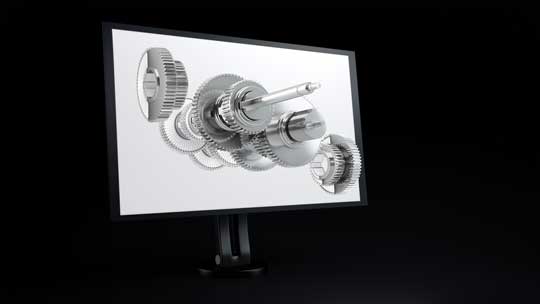TVs have come a long way since their early days almost a hundred years ago. What was once unattainable for all but the most wealthy, now sits in every living room, with many homes containing more than one TV.
The original sets were big, bulky and very heavy due to the cathode ray tube, steering coils and other, now outdated, technology contained within. The screens were small, dramatically curved and dark grey in color when switched off, with the thick dark wood box surround making a substantial impact in the living room, where they were usually placed. They were the height of fashionable luxury and a sign of an enviable bank balance.
TVs continued to be designed as large blocky boxes until, finally, contemporary technology enabled the surround to slim down, and the screen size to increase. This coincided, naturally, with the escalation of stylishly designed marketing campaigns. Alongside the TV, computer technology was becoming increasingly sophisticated, and designers, who for many years, had been skillfully working by hand, using meticulous drawings, diagrams and calligraphy, were slowly being replaced with the far more efficient and economical Computer Aided Design (CAD) programs.
With vastly improved resolution and a hitherto only dreamed of color range, TV design and technology has moved on a pace. Screens are now a flat expanse of smooth sleekness, with a choice of sizes from 32 inches to almost cinematic proportions, and framed by near invisible bezels. The inclusion of smart functionality, and the ability to manage the running of a smart enabled home from the comfort of your own sofa, have given TV a power and prominence that couldn’t even be imagined a hundred years ago.
Read reviews of flat screen TVs at TV Mates
Meanwhile, computer technology has taken a massive leap forward, with vastly improved capabilities, including faster, more powerful processors, the use of AI technology, unbelievably huge memories and the ability to store an almost infinite amount of data.
Many modern TVs and computers have the option of being interchangeable, and many users have taken advantage of this ability, known as mirroring.
Running your computer through the TV screen offers a wealth of advantages for many professions, especially for remote staff. The design industry has made full use of this option. Having already discovered the improved creativity and increased productivity delivered by home workers, and using easily accessible, larger and more cost effective flat screen TVs, computer aided design has come into its own.
CAD programs are particularly color critical, and with the unbelievable range available TV, coupled with the ever increasingly quality of flat screen resolution, which reduces eye strain – a frequent complaint of designers, make this a viable option, and one which works to everyone’s benefit. Games designers, too, can take full advantage of the improved graphics and wide color gamut available with high tech TVs, especially models with 4K and Ultra High Definition capabilities.
There are several ways to connect your computer to your TV screen. The simplest and most reliable method is via an HDMI cable. Insert one end of the cable into the computer’s port, and the other into the TV’s port, making a note of which numbered port you choose. Usually the two devices synch automatically, however it can be performed manually through the remote control. Select the button marked ‘input’, ‘source’ or similar, and locate the port the HDMI cable is inserted into.

If your TV is smart enabled with WiFi features, connecting the two wirelessly is also an easy task. All the latest laptops and PCs come with an inbuilt mirroring option via Windows 10. This guides you through the syncing process, adding the TV screen as a new device. If, however, your TV lacks WiFi connectivity, Google Chromecast is designed to ‘cast’ your entire computer to your TV screen, allowing it to replace your monitor, despite the lack of WiFi, providing a stable, reliable connection.
By allowing designers to sit back and take advantage of the multiple benefits the TV screen offers, instead of pouring over a monitor, is a refreshingly modern twist on the out-of-date 9-5, and makes full use of their talents from the comfort of their own sofa. This results in improved free flowing original ideas and creativity, a decrease in work-induced stress, and a more productive output all round. Everyone’s happy!
